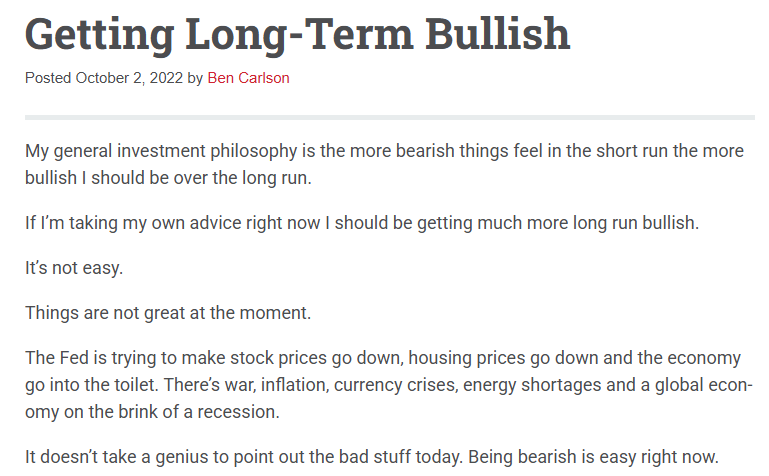A reader asks:
The sentiment is quite bearish, and for good reason. How do you balance discussing/having a bearish outlook, with the tenets of staying invested for the long-term? Said another way, how do you answer or deal with clients that may hear these discussions and feel the need or ask to sell a portion of their portfolio to wait and see or “buy lower.”
Some people view being bearish or bullish as an investment stance.
I view them as emotions — fear and greed. Emotions themselves aren’t good or bad per se. They just are. It’s what makes us human.
And sometimes you can’t help how you feel.
One of my all-time favorite anecdotes about the human condition comes from Influence by Robert Cialdini:
It concerns a World War II soldier who returned to his home in the Balkans after the war and shortly thereafter stopped speaking. Medical examinations could find no physical cause for the problem. There was no wound, no brain damage, no vocal impairment. He could read, write, understand a conversation, and follow orders. Yet he would not talk–not for his doctors, not for his friends, not even for his pleading family.
Perplexed and exasperated, his doctors moved him to another city and placed him in a veterans’ hospital where he remained for thirty years, never breaking his self-imposed silence and sinking into a life of social isolation.
Then one day, a radio in his ward happened to be tuned to a soccer match between his hometown team and a traditional rival. When at a crucial point of play the referee called a foul against a player from the man’s home team, the mute veteran jumped from his chair, glared at the radio, and spoke his first words in more than three decades:
“You dumb ass!” he cried. “Are you trying to give them the match?”
With that, he returned to his chair and to a silence he never again violated.
You’re not always in control of your emotions.
Should you act on those emotions? That’s a different question.
Joel Greenblatt wrote a book called The Little Book That Beats the Market that lays out his “Magic Formula” for investing in stocks. That formula is a quantitative screen that looks for companies with high returns on capital combined with low valuations.
There was even a companion website that allowed you to run an updated list of the Magic Formula stocks. Some people wanted to use the formula on their own, while others preferred Greenblatt and his team to do it for them.
So some investors used their discretion by picking and choosing different stocks from the list while others had the process automated for them. After a few years they looked at the results and discovered the automated strategies crushed the discretionary strategies.
The discretionary investors avoided the biggest winners, changed their strategy when it wasn’t working, held more cash when stocks were down and bought more stocks when they were up, thus buying high and selling low — a tale as old as time.
They allowed emotions to dictate their investment decisions.
However, the most ironic finding is that the single most effective strategy was the one that did nothing. One investor opened an account, bought all the stocks from the screen, and never made any trades whatsoever.
Doing nothing outperformed both the discretionary stock-pickers and the automated stock-pickers.
Being bullish or bearish is also subjective based on where you are in your investing lifecycle. A stock market crash would not be very much fun for a retiree who is living off their portfolio. But a stock market crash for a younger or middle aged person who is going to be a net saver for the foreseeable future would allow them to snap up stocks on sale.
Risk is in the eye of the time horizon.
There have been plenty of times in my two-decade-long investing career where I’ve felt plenty bullish or bearish. Sometimes those feeling were right but more often than not they were wildly off the mark.
Here’s something I wrote back in October of 2022:

Everything at the time felt bearish. Inflation was 9%. The Fed was actively trying to slow the economy and increase the unemployment rate. The S&P 500 was down 25%. Those feelings were right in the moment but wrong for the future.
That was basically the bottom of the bear market.
When it comes to client conversations there are certainly going to be people who feel bullish or bearish depending on the headlines. I like to think about those conversations through the following questions:
- Have your financial circumstances changed?
- Have your spending patterns changed?
- Have your financial goals changed?
- Has the risk-reward relationship changed?
Your financial plan typically matters more than your feelings about the market or economy.
Acting on your feelings of being bullish or bearish might work sometimes but most of the time you should try to stay out of your own way. This is why it’s important to place constraints on yourself before you begin to feel those emotions.
I’ve always been in the camp that you should think about portfolio changes through the lens of risk and reward not bullish or bearish.
Bullish and bearish is for traders and hedge fund managers.
Risk and reward is for investors.
Taking emotions out of the decision-making process will almost always be the right move because most of the time it’s difficult to see your own behavioral biases in the heat of the moment.
I discussed this question in further detail on this week’s Ask the Compound:
Barry Ritholtz joined me on the show to answer more questions about the best case trade war scenarios, how to manage $4 million, where to stash your down payment savings and how to prepare for a recession.
Further Reading:
Getting Long-Term Bullish
